Jean-Antoine Watteau
Jean-Antoine Watteau (UK: /ˈwɒtoʊ/, US: /wɒˈtoʊ/,[2][3] French: [ʒɑ̃ ɑ̃twan vato]; baptised October 10, 1684 – died July 18, 1721),[4] commonly referred to as Antoine Watteau, was a French painter whose brief career spurred the revival of interest in colour and movement, as seen in the tradition of Correggio and Rubens. He revitalized the waning Baroque style, shifting it to the less severe, more naturalistic, less formally classical, Rococo. Watteau is credited with inventing the genre of fêtes galantes, scenes of bucolic and idyllic charm, suffused with a theatrical air. Some of his best known subjects were drawn from the world of Italian comedy and ballet.
Antoine Watteau | |
|---|---|
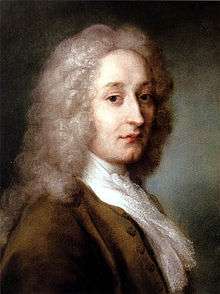 Watteau in the last year of his life, by Rosalba Carriera, 1721. | |
| Born | Jean-Antoine Watteau baptised October 10, 1684 |
| Died | July 18, 1721 (aged 36) Nogent-sur-Marne,[1] France |
| Nationality | French |
| Known for | Painting and architecture |
Notable work | Embarkation for Cythera, 1717–1718 L'Enseigne de Gersaint, 1720–1721 |
| Movement | Rococo |
Early life and training
Watteau was born in October 1684 in the town of Valenciennes[1] which had recently passed from the Spanish Netherlands to France. His father, Jean-Philippe Watteau, was a roofer given to brawling.[5] Showing an early interest in painting, Jean-Antoine may have been apprenticed to Jacques-Albert Gérin, a local painter, and his first artistic subjects were charlatans selling quack remedies on the streets of Valenciennes.[1] Watteau left for Paris in 1702.[6] After a period spent as a scene-painter, and in poor health, he found employment in a workshop at Pont Notre-Dame, making copies of popular genre paintings in the Flemish and Dutch tradition; it was in that period that he developed his characteristic sketchlike technique.[7]
His drawings attracted the attention of the painter Claude Gillot, and by 1705 he was employed as an assistant to Gillot, whose work, imbued with the spirit of the Renaissance, represented a reaction against the turgid official art of Louis XIV's reign.[8] In Gillot's studio Watteau became acquainted with the characters of the commedia dell'arte (which moved onto the théâtre de la foire following the Comédie-Italienne departure in 1697), a favorite subject of Gillot's that would become one of Watteau's lifelong passions.[4]
After a quarrel with Gillot, Watteau moved to the workshop of Claude Audran III, an interior decorator, under whose influence he began to make drawings admired for their consummate elegance. Audran was the curator of the Palais du Luxembourg, and from him Watteau acquired his knowledge of decorative art and ornamental design.[7] At the palace, Watteau was able to see the magnificent series of canvases painted by Peter Paul Rubens for Queen Marie de Medici. The Flemish painter would become one of his major influences, together with the Venetian masters that he would later study in the collection of his patron and friend, the banker Pierre Crozat.[4]
During this period Watteau painted The Departing Regiment, the first picture in his second and more personal manner, showing influence of Rubens, and the first of a long series of camp pictures. He showed the painting to Audran, who made light of it, and advised him not to waste his time and gifts on such subjects. Watteau determined to leave him, advancing as excuse his desire to return to Valenciennes. He found a purchaser, at the modest price of 60 livres, in a man called Sirois, the father-in-law of his later friend and patron Edme-François Gersaint, and was thus enabled to return to the home of his childhood. In Valenciennes he painted a number of the small camp-pieces, notably the Camp-Fire, which was again bought by Sirois, the price this time being raised to 200 livres.[7]
Later career
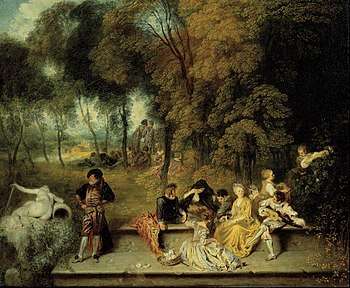
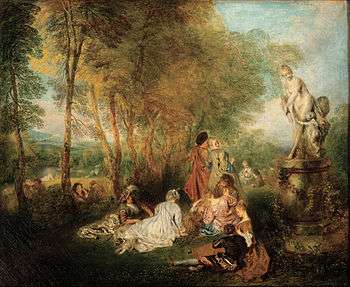
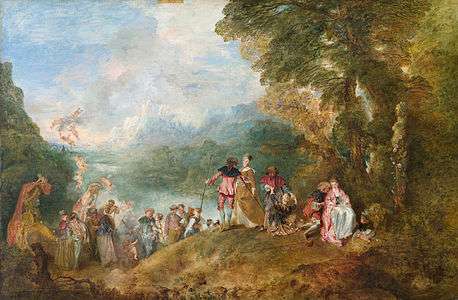
In 1709, Watteau tried to obtain a one-year stay in Rome by winning the Prix de Rome from the Academy, but managed only to get awarded with the second prize.[9] In 1712 he tried again and was persuaded by Charles de La Fosse that he had nothing to learn from going to Rome; thanks to Fosse he was accepted as an associate member of the Academy in 1712 and a full member in 1717.[7][10] He took those five years to deliver the required "reception piece", but it was one of his masterpieces: the Pilgrimage to Cythera, also called the Embarkation for Cythera.[11]
Watteau then went to live with the collector Crozat, who eventually on his death in 1740 left around 400 paintings and 19,000 drawings by the masters. Thus Watteau was able to spend even more time becoming familiar with the works of Rubens and the Venetian masters.[12] He lacked aristocratic patrons; his buyers were bourgeois such as bankers and dealers. Among his most famous paintings, beside the two versions of the Pilgrimage to Cythera, one in the Louvre, the other in the Schloss Charlottenburg, Berlin, are Pierrot (long identified as "Gilles"), Fêtes venitiennes, Love in the Italian Theater, Love in the French Theater, "Voulez-vous triompher des belles?" and Mezzetin. The subject of his hallmark painting, Pierrot (Gilles), is an actor in a white satin costume who stands isolated from his four companions, staring ahead with an enigmatic expression on his face.[13]
Watteau's final masterpiece, the Shop-sign of Gersaint, exits the pastoral forest locale for a mundane urban set of encounters. Painted at Watteau's own insistence, "in eight days, working only in the mornings ... in order to warm up his fingers",[14] this sign for the shop in Paris of the paintings dealer Edme François Gersaint is effectively the final curtain of Watteau's theatre. It has been compared with Las Meninas as a meditation on art and illusion.[14] The scene is an art gallery where the façade has magically vanished, and the gallery and street in the canvas are fused into one contiguous drama.[15]
Watteau alarmed his friends by a carelessness about his future and financial security, as if foreseeing he would not live for long. In fact he had been sickly and physically fragile since childhood. In 1720, he travelled to London, England, to consult Dr. Richard Mead, one of the most fashionable physicians of his time and an admirer of Watteau's work. However, London's damp and smoky air offset any benefits of Dr. Mead's wholesome food and medicines. Watteau returned to France, spending six months with Gersaint,[12] and then spent his last few months on the estate of his patron, Abbé Haranger, where he died in 1721, perhaps from tuberculous laryngitis, at the age of 36. The Abbé said Watteau was semi-conscious and mute during his final days, clutching a paint brush and painting imaginary paintings in the air.[16]
His nephew, Louis Joseph Watteau, son of Antoine's brother Noël Joseph Watteau (1689–1756), and grand nephew, François-Louis-Joseph Watteau, son of Louis, followed Antoine into painting.
Critical assessment and legacy
Little known during his lifetime beyond a small circle of his devotees, Watteau "was mentioned but seldom in contemporary art criticism and then usually reprovingly".[17] Sir Michael Levey once noted that Watteau "created, unwittingly, the concept of the individualistic artist loyal to himself, and himself alone".[18] If his immediate followers, Lancret and Pater, would depict the unabashed frillery of aristocratic romantic pursuits, Watteau in a few masterpieces anticipates an art about art, the world of art as seen through the eyes of an artist. In contrast to the Rococo whimsicality and licentiousness cultivated by Boucher and Fragonard in the later part of Louis XV's reign, Watteau's theatrical panache is usually tinged with a note of sympathy, wistfulness, and sadness at the transience of love and other earthly delights.[19] Famously, the Victorian essayist Walter Pater wrote of Watteau: "He was always a seeker after something in the world, that is there in no satisfying measure, or not at all."[20]:414
Watteau was a prolific draftsman. His drawings, typically executed in trois crayons technique, were collected and admired even by those, such as count de Caylus or Gersaint, who found fault with his paintings.[4] In 1726 and 1728, Jean de Jullienne published suites of etchings after Watteau's drawings, and in 1735 he published a series of engravings after his paintings, The Recueil Jullienne.[4] The quality of the reproductions, using a mixture of engraving and etching following the practice of the Rubens engravers, varied according to the skill of the people employed by Jullienne, but was often very high. Such a comprehensive record was hitherto unparalleled.[4] This helped disseminate his influence round Europe and into the decorative arts.
Watteau's influence on the arts (not only painting, but the decorative arts, costume, film, poetry, music) was more extensive than that of almost any other 18th-century artist. The Watteau dress, a long, sacklike dress with loose pleats hanging from the shoulder at the back, similar to those worn by many of the women in his paintings, is named after him. According to Konody's critical assessment in the Encyclopædia Britannica Eleventh Edition, in part, "in his treatment of the landscape background and of the atmospheric surroundings of the figures can be found the germs of Impressionism".[12] His influence on later generations of painters may have been less apparent in France than in England, where J.M.W. Turner was among his admirers.[21] A revived vogue for Watteau began in England during the British Regency, and was later encapsulated by the Goncourt brothers in France (Edmond de Goncourt having published a catalogue raisonné in 1875) and the World of Art union in Russia.
In 1984 Watteau societies were created in Paris, by Jean Ferré, and London, by Dr. Selby Whittingham. A major exhibition in Paris, Washington and Berlin commemorated the 1984 tercentenary of his birth. Since 2000 a Watteau centre has been established at Valenciennes by Professor Chris Rauseo. A catalogue of his drawings has been compiled by Pierre Rosenberg, replacing the one by Sir Karl Parker, and Alan Wintermute is preparing one for his paintings.
Gallery
 Polish Woman Standing (National Museum, Warsaw)
Polish Woman Standing (National Museum, Warsaw)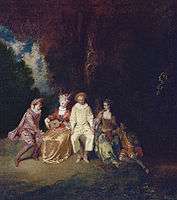 A Pierrot
A Pierrot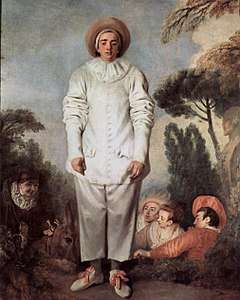 Watteau's commedia dell'arte player of Pierrot, ca 1718–19, traditionally identified as "Gilles" (Louvre)
Watteau's commedia dell'arte player of Pierrot, ca 1718–19, traditionally identified as "Gilles" (Louvre)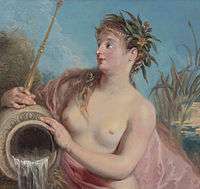 Quellnymphe
Quellnymphe- The Love Song
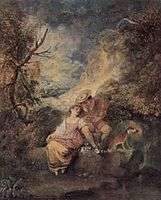 The hunter, National Gallery of Scotland
The hunter, National Gallery of Scotland The Dance
The Dance Feast in Venice
Feast in Venice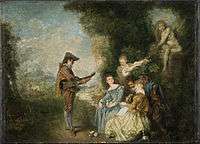 The Love Lesson
The Love Lesson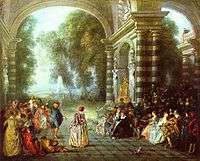 Les Plaisirs du bal
Les Plaisirs du bal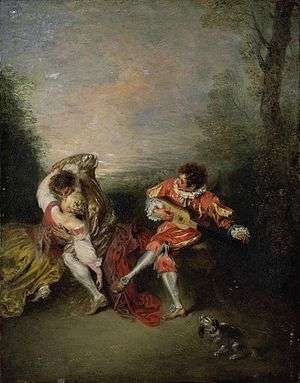 La Surprise, c. 1718.
La Surprise, c. 1718.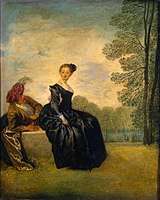 La Boudeuse (Hermitage Museum): "Flirting coquettishly yet innocently, the artist's imaginary heroes—the deliberately indifferent lady and her insistently attentive cavalier—are shown with gentle irony. Their fragile, elegant world is dominated by a lyrical mood with just a touch of elegiac melancholy."[22]
La Boudeuse (Hermitage Museum): "Flirting coquettishly yet innocently, the artist's imaginary heroes—the deliberately indifferent lady and her insistently attentive cavalier—are shown with gentle irony. Their fragile, elegant world is dominated by a lyrical mood with just a touch of elegiac melancholy."[22] The Italian Comedians, 1721
The Italian Comedians, 1721 Pilgrimage to Cythera is an embellished repetition of his painting of 1717, and exemplifies the frivolity and sensuousness of Rococo painting. (1721, Berlin)
Pilgrimage to Cythera is an embellished repetition of his painting of 1717, and exemplifies the frivolity and sensuousness of Rococo painting. (1721, Berlin)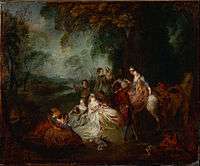 Fete Champetre, 1722
Fete Champetre, 1722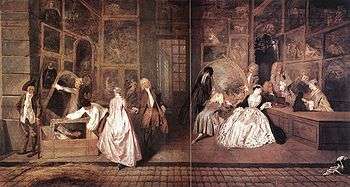 L'Enseigne de Gersaint (1720): In one of Watteau's last paintings, the portrait of Louis XIV and his own artworks are being packed away. The painter had no reason to expect that his name would be remembered long.
L'Enseigne de Gersaint (1720): In one of Watteau's last paintings, the portrait of Louis XIV and his own artworks are being packed away. The painter had no reason to expect that his name would be remembered long.%2C_c._1717-1718%2C_NGA_46149.jpg) Ceres (Summer), c. 1717–1718, National Gallery of Art
Ceres (Summer), c. 1717–1718, National Gallery of Art
References
- Levey, Michael (1993). Painting and sculpture in France 1700-1789. New Haven: Yale University Press. p. 29. ISBN 0300064942.
- Wells, John C. (2008). Longman Pronunciation Dictionary (3rd ed.). Longman. ISBN 978-1-4058-8118-0.
- Jones, Daniel (2011). Roach, Peter; Setter, Jane; Esling, John (eds.). Cambridge English Pronouncing Dictionary (18th ed.). Cambridge University Press. ISBN 978-0-521-15255-6.
- Wine, Humphrey, and Annie Scottez-De Wambrechies. "Watteau" in Grove Art Online. oxfordartonline.com Oxford University Press. Retrieved 8 February 2014.
- Grasselli, Rosenberg & Parmantier 1984, p. 17.
- Grasselli, Rosenberg & Parmantier 1984, p. 19.
- Konody 1911, p. 417.
- Michel, Marianne Roland. "Gillot, Claude". Grove Art Online. Oxford Art Online. Oxford University Press. Web. 10 Apr. 2016.
- Grasselli, Rosenberg & Parmantier 1984, p. 20.
- Grasselli, Rosenberg & Parmantier 1984, p. 21.
- Grasselli, Rosenberg & Parmantier 1984, p. 396.
- Konody 1911, p. 418.
- Grasselli, Rosenberg & Parmantier 1984, pp. 429–434.
- Baetjer, Katharine, ed. (2009). Watteau, Music, and Theater. Rosenberg, Pierre (an introduction by); Cowart, Georgia J. (an essay by). New York: The Metropolitan Museum of Art. p. 6. ISBN 978-1-58839-335-7..
- Schwartz, Sanford (1990). Artists and Writers. New York: Yarrow Press. pp. 140–141. ISBN 1-878274-01-5.
- Dormandy 2000, p. 11.
- Hauser, Arnold (1999). Rococo, Classicism and Romanticism. Routledge (UK). p. 21.
- Levey 1966.
- Cunningham, Lawrence & Reich, John J. (2010). Culture and Values: A Survey of the Western Humanities. Boston, MA: Wadsworth Cengage Learning. p. 399. ISBN 9780495568773.
- Pater, Walter (October 1885). "A Prince of Court Painters". Macmillan's Magazine. Vol. 52 no. 312. pp. 401–414 – via the Internet Archive.
- Gowing, Lawrence, and Michel Laclotte. 1987. Paintings in the Louvre. New York: Stewart, Tabori & Chang. p. 506. ISBN 1556700075.
- "La Boudeuse (The Capricious Girl)". Hermitagemuseum.org. The State Hermitage Museum. Retrieved September 27, 2017.
Bibliography
- Camesasca, Ettore, ed. (1971). The Complete Paintings of Watteau. Classics of the World's Great Art. Introduction by John Sunderland. New York: Harry N. Abrams. ISBN 0810955253. OCLC 143069 – via the Internet Archive.CS1 maint: ref=harv (link)
- Dacier, Émile; Vuaflart, Albert (1921–1929). Jean de Jullienne et les graveurs de Watteau au XVIIIe siecle. Paris: Pour les membres de la Société. OCLC 1248768.
- Dormandy, Thomas (2000). The White Death: the History of Tuberculosis. New York University Press.CS1 maint: ref=harv (link)
- Goncourt, Edmond et Jules de (1881). L'art du XVIIIme siècle [The Art of the Eighteenth Century]. 1. Paris: G. Charpentier. OCLC 1048224230 – via the Internet Archive.CS1 maint: ref=harv (link)
- Grasselli, Margaret Morgan; Rosenberg, Pierre & Parmantier, Nicole, eds. (1984). Watteau, 1684-1721 ; National Gallery of Art, June 17—September 23, 1984; Galeries Nationales du Grand Palais, Paris, October 23, 1984—January 28, 1985; Schloss Charlottenburg, Berlin, February 22—May 26, 1985. Washington: National Gallery of Art. ISBN 0-89468-074-9. OCLC 557740787 – via the National Gallery of Art archive.CS1 maint: ref=harv (link)
- Hind, Charles Lewis (1910). Watteau. London: T.C. & E.C. Jack – via the Internet Archive.CS1 maint: ref=harv (link)
- Konody, Paul George (1911). . In Chisholm, Hugh (ed.). Encyclopædia Britannica. 28 (11th ed.). Cambridge University Press. pp. 417–418.CS1 maint: ref=harv (link)
- Levey, Michael (1966). Rococo to Revolution. Thames and Hudson.CS1 maint: ref=harv (link)
- Mauclair, Camille (1906). Antoine Watteau (1684-1721). Duckworth & Co – via the Internet Archive.
- Mollett, John William (1883). Watteau. Illustrated Biographies of the Great Artists. London: S. Low, Marston, Searle & Rivington – via the Internet Archive.CS1 maint: ref=harv (link)
- Phillips, Claude (1895). Antoine Watteau. Seeley and co. Limited – via the Internet Archive.
- Plax, Julie Anne (2000). Watteau and the Cultural Politics of Eighteenth-Century France. Cambridge etc.: Cambridge University Press. ISBN 0-521-64268-X. OCLC 803847893.CS1 maint: ref=harv (link)
- Posner, Donald (1984). Antoine Watteau. Ithaca, NY: Cornell University Press. ISBN 0-8014-1571-3. OCLC 10736607.CS1 maint: ref=harv (link)
- Roland Michel, Marianne (1984). Watteau. Flammarion. ISBN 9782080120205. OCLC 417153549.
- Schneider, Pierre (1967). The World of Watteau. Time-Life Books.
- Sheriff, Mary D., ed. (2006). Antoine Watteau: Perspectives on the Artist and the Culture of His Time. Newark: University of Delaware. ISBN 978-0-87413-934-1. OCLC 185456942.
- Staley, Edgcumbe (1902). Watteau and His School. London: George Bell and Sons – via the Internet Archive.
- Stein, Perrin. "Antoine Watteau (1684–1721)." In Heilbrunn Timeline of Art History. New York: The Metropolitan Museum of Art, 2000–. (October 2003)
- The Watteau Society Bulletin, London.
- Martin Eidelberg, watteauandhiscircle.org
External links
| Wikimedia Commons has media related to Antoine Watteau. |
- 40 paintings by or after Jean-Antoine Watteau at the Art UK site
- Alphabetical list of accepted paintings and copies at A Watteau Abecedario
- The Rococo and Watteau
- www.Jean-Antoine-Watteau.org 89 works by Antoine Watteau
- Watteau paintings at the Web Gallery of Art
- Bell, Julian (February 12, 2009). "The Pleasure of Watteau". The New York Review of Books. Retrieved May 3, 2020.
- Works by Watteau in the collection of the Cooper-Hewitt, National Design Museum
- The Watteau Abecedario http://watteau-abecedario.org/default.htm